Introduction
Natural disasters such as droughts and floods can have devastating impacts on communities, economies, and ecosystems. Understanding the terminology associated with these events is crucial for preparedness, response, and recovery efforts. This article provides a comprehensive list of English vocabulary related to drought and flood disasters, categorized for easy reference.
Drought
General Terms
- Drought: A prolonged period of dry weather, typically resulting in water scarcity.
- Arid: Characterized by a lack of rainfall and moisture.
- Hydrology: The scientific study of water on Earth, including its distribution, movement, and interaction with the environment.
- Water scarcity: A situation where the available water resources are insufficient to meet the needs of the population.
Causes and Effects
- El Niño: A climate pattern that causes the Pacific Ocean to warm, leading to changes in weather patterns and increased droughts in some regions.
- La Niña: A climate pattern characterized by cooler Pacific Ocean temperatures, often associated with wetter conditions and reduced drought risk.
- Deforestation: The clearing of forests, which can lead to soil erosion and reduced water retention, contributing to drought conditions.
- Desertification: The process by which land becomes desert, typically due to climate change and human activities.
- Water conservation: The practice of using water efficiently to reduce consumption and waste.
Response and Management
- Water management: The planning, development, and operation of water resources to meet present and future demands.
- Irrigation: The artificial application of water to the soil to support plant growth.
- Drought mitigation: Actions taken to reduce the impact of drought on human activities and ecosystems.
- Water rationing: The allocation of water resources to different users in a controlled manner to ensure fair and efficient use.
- Drought relief: Assistance and support provided to communities affected by drought.
Flood
General Terms
- Flood: The overflow of water that submerges land that is normally dry.
- Inundation: The process of being flooded or overwhelmed.
- Deluge: A great flood; a large volume of water.
- Overflow: The act of spilling over; the condition of being overflowed.
Causes and Effects
- Heavy rainfall: Excessive rainfall over a short period of time, often leading to flooding.
- Storm surge: An abnormal rise in sea level during a storm, causing coastal flooding.
- Riverine flood: A flood caused by the overflow of a river.
- Flash flood: A sudden flood caused by heavy rainfall, melting snow, or a sudden break in an ice dam.
- Erosion: The wearing away of land by water, wind, or ice, which can exacerbate flooding.
- Flooding: The overflow of water onto normally dry land.
Response and Management
- Evacuation: The process of moving people from an area that is threatened by flooding.
- Flood warning: A notice that flooding is imminent or already occurring.
- Floodplain: An area of land adjacent to a river or stream that is subject to flooding.
- Levee: A wall or embankment built to prevent a river or lake from overflowing.
- Flood insurance: Insurance that protects property owners against flood damage.
- Flood relief: Assistance and support provided to communities affected by flooding.
Conclusion
Understanding the terminology associated with drought and flood disasters is essential for effective disaster management and preparedness. This vocabulary list provides a comprehensive guide to the key terms and concepts related to these natural events, helping to ensure clear communication and informed decision-making in times of crisis.
